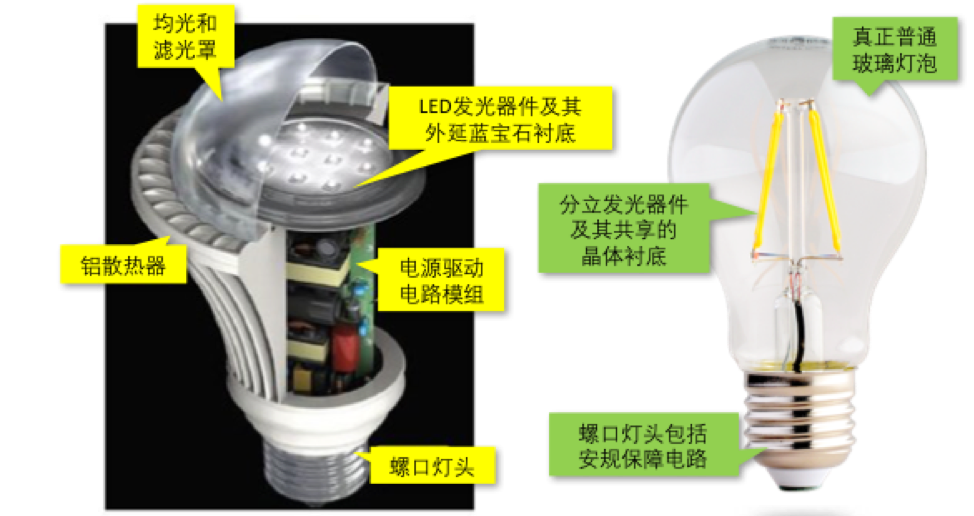To identify an “energy-saving product”, it is common among industries and users that a New Product is better. Factually all products have their costs and environmental impacts through the lifetime: process technology development, production, marketing and distribution, application, maintenance, retire, disposal and recycle, and so on.
(1) Cost impacts span through a product’s lifetime (time): For example, LED lighting products’ higher price is determined by 3 cost factors: (1) the investment is high: semiconductor process technology licensing and manufacturing equipment, are very expensive, as capital items; (2) the production costs are high: materials, energy consumption, manpower, supply chains, dispose and cleaning of exhausts, are very expensive, as common in semiconductor industry; (3) product assembly are complicated: until achieving massive production, quantity and quality are both restrained by lack of automated assembly, and LED lights are usually made up of 10-100 times in numbers of parts comparing to a single light bulb. In these three, LED lights actually is not as good as conventional products (such as light bulbs, tubes and flood lights). If through 3 years using LED lights that a user can “pay back” the “debt” by much lower electric bills, that significantly saved a lot, then we get-even in the competition. Then we expect the 3-year old LED lights then to further win the competition. That would demand: (1) lower cost in maintenance and last longer; (2) replacement cost is low; (3) thrifty and clean in disposing replaced old products (otherwise they will be still in use), as well need to have a low-cost solution to retire the old manufacturing capacity and infrastructure (otherwise they are still producing, making money and in depreciation). In these 2 latter aspects, LED lights must be doing very well to claim that they are better “energy-saving products”.
(2) Cost impacts of a product’s life-span crossing territories (space): For example, semiconductor solar cell products intended a geological separation between places to manufacture the product and places to use the product: On the manufacture side, it increased use of local natural resources, materials, energy, environment cleaning and manpower, in China; while on the products side, it used in Western market, reduced use of electricity. Thus the profit that China earned from Western countries must have been dedicated to compensate or to make up local damages of resource and environment (if natural resource and environment conditions do have means to reverse), or the originally thought selling products now becomes selling local resources for profit, and get paid to destroy local environment.
Such a new product is just again fall to our industrialized society’s routine stimulation of productivity growth. There is nothing to do with saving and cleaning. Even the new product’s function has been actually taken off from the equation of this macro economy.
对“节能产品”的理解,产业和用户往往热衷于新产品。其实所有产品的成本和消耗全过程,包括了工艺投资、产品制造、市场流通、应用和维护和退役处理各个阶段。
1. 时间:产品成本的冲击在于其生命期的全过程。例如,LED的高价格,取决于三个成本因素:(1)投资大:半导体制造工艺和装备的研发和制造成本;(2)制造成本高:包括材料、能源、人力和物力的消耗以及排放处理等;(3)灯具组装复杂性高、制造规模尚小和生产自动化程度低。在这些成本方面事实上LED都不能与任何传统光源(白炽灯、荧光灯、溴钨灯等)相竞争;但是LED的高光效和节能结果可能在长期使用中以节能来“偿还”以上三个方面的不足。如果3年节省的电费“还清”了在以上三个方面的“借贷”,在同等起点上,我们相继的期望是,(1)使用成本:LED灯具在使用中保持较低的维护成本、更低的更换成本和更长的使用寿命。(2)产品替换成本:能相对节俭和净化地处理掉被替换的灯具(否则还在使用中)和被淘汰掉的光源产品制造业(否则还在生产、盈利和折旧)。在这两个方面,我们希望LED照明能胜过传统灯具和光源,才能称为是个划算的“节能新产品”。
2. 空间:产品成本的冲击在于其在生命过程中所跨地域,往往以生产地(制造业成本低)和使用地(商品消费能力高)划分。例如,光伏产品的异地产业和市场,决定了两个世界地区的环保冲击:(1)在产地中国,制造业增加了对当地的自然资源损失、材料消耗、能耗消耗、环保代价、人力物力代价:(2)市场和使用在外国,减少了当地的电能消耗。如此中国制造商所取得的毛利则必须专门用于“恢复或补偿”当地资源和环境的损失(如果自然资源和环境状态真的可以逆转的话),否则本意中的“制造和销售产品”即变成了变卖本地资源和合同化地破坏本地环境。
一种新产品的推出,可能会沦为工业化社会用于刺激生产力增长的老一套,并无益于任何节俭和净化。至于该新产品本身的意义,(如同代数中的分解因式)在宏观经济过程中其实已经被简约掉了。

